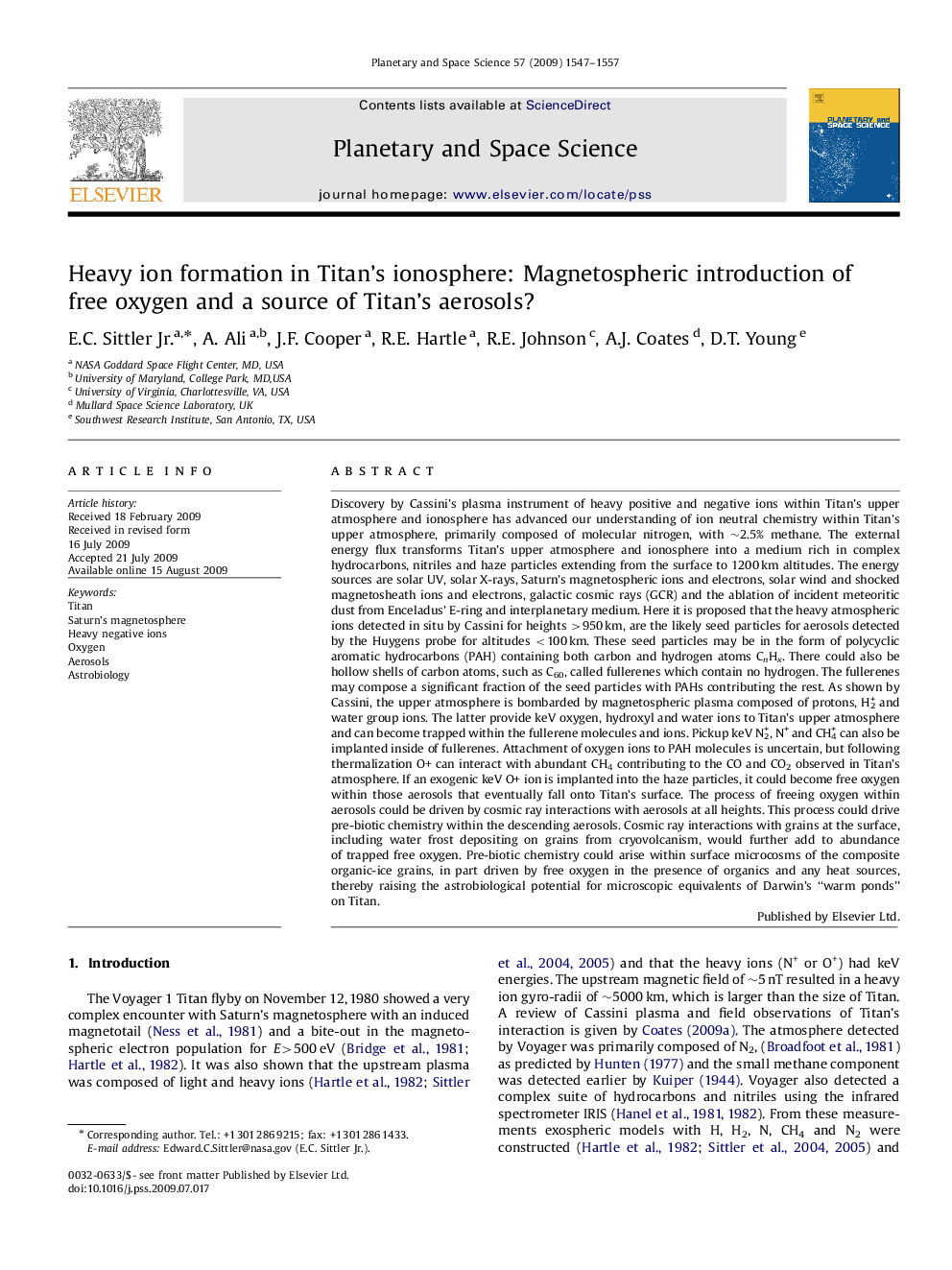| کد مقاله | کد نشریه | سال انتشار | مقاله انگلیسی | نسخه تمام متن |
|---|---|---|---|---|
| 1782014 | 1022314 | 2009 | 11 صفحه PDF | دانلود رایگان |
عنوان انگلیسی مقاله ISI
Heavy ion formation in Titan's ionosphere: Magnetospheric introduction of free oxygen and a source of Titan's aerosols?
دانلود مقاله + سفارش ترجمه
دانلود مقاله ISI انگلیسی
رایگان برای ایرانیان
کلمات کلیدی
موضوعات مرتبط
مهندسی و علوم پایه
علوم زمین و سیارات
فیزیک زمین (ژئو فیزیک)
پیش نمایش صفحه اول مقاله

چکیده انگلیسی
Discovery by Cassini's plasma instrument of heavy positive and negative ions within Titan's upper atmosphere and ionosphere has advanced our understanding of ion neutral chemistry within Titan's upper atmosphere, primarily composed of molecular nitrogen, with ~2.5% methane. The external energy flux transforms Titan's upper atmosphere and ionosphere into a medium rich in complex hydrocarbons, nitriles and haze particles extending from the surface to 1200Â km altitudes. The energy sources are solar UV, solar X-rays, Saturn's magnetospheric ions and electrons, solar wind and shocked magnetosheath ions and electrons, galactic cosmic rays (GCR) and the ablation of incident meteoritic dust from Enceladus' E-ring and interplanetary medium. Here it is proposed that the heavy atmospheric ions detected in situ by Cassini for heights >950Â km, are the likely seed particles for aerosols detected by the Huygens probe for altitudes <100Â km. These seed particles may be in the form of polycyclic aromatic hydrocarbons (PAH) containing both carbon and hydrogen atoms CnHx. There could also be hollow shells of carbon atoms, such as C60, called fullerenes which contain no hydrogen. The fullerenes may compose a significant fraction of the seed particles with PAHs contributing the rest. As shown by Cassini, the upper atmosphere is bombarded by magnetospheric plasma composed of protons, H2+ and water group ions. The latter provide keV oxygen, hydroxyl and water ions to Titan's upper atmosphere and can become trapped within the fullerene molecules and ions. Pickup keV N2+, N+ and CH4+ can also be implanted inside of fullerenes. Attachment of oxygen ions to PAH molecules is uncertain, but following thermalization O+ can interact with abundant CH4 contributing to the CO and CO2 observed in Titan's atmosphere. If an exogenic keV O+ ion is implanted into the haze particles, it could become free oxygen within those aerosols that eventually fall onto Titan's surface. The process of freeing oxygen within aerosols could be driven by cosmic ray interactions with aerosols at all heights. This process could drive pre-biotic chemistry within the descending aerosols. Cosmic ray interactions with grains at the surface, including water frost depositing on grains from cryovolcanism, would further add to abundance of trapped free oxygen. Pre-biotic chemistry could arise within surface microcosms of the composite organic-ice grains, in part driven by free oxygen in the presence of organics and any heat sources, thereby raising the astrobiological potential for microscopic equivalents of Darwin's “warm ponds” on Titan.
ناشر
Database: Elsevier - ScienceDirect (ساینس دایرکت)
Journal: Planetary and Space Science - Volume 57, Issue 13, November 2009, Pages 1547-1557
Journal: Planetary and Space Science - Volume 57, Issue 13, November 2009, Pages 1547-1557
نویسندگان
E.C. Jr., A. Ali, J.F. Cooper, R.E. Hartle, R.E. Johnson, A.J. Coates, D.T. Young,